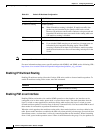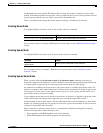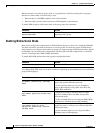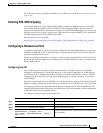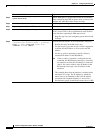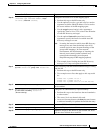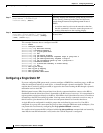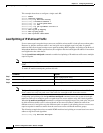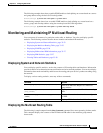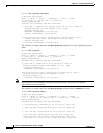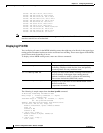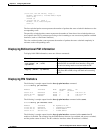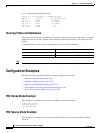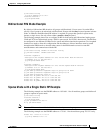
33-22
Software Configuration Guide—Release 15.0(2)SG
OL-23818-01
Chapter 33 Configuring IP Multicast
Configuring IP Multicast Routing
This example shows how to configure a single-static RP:
Switch> enable
Switch# configure terminal
Switch(config)# ip multicast-routing
Switch(config)# interface ethernet 1
Switch(config-if)# ip pim sparse-mode
Switch(config-if)# exit
Switch(config)# ip pim rp-address 192.168.0.0
Switch(config)# end
Switch# show ip pim rp mapping
Switch# show ip igmp groups
Switch# show ip mroute cbone-audio
Load Splitting of IP Multicast Traffic
If two or more equal-cost paths from a source are available, unicast traffic is load split across those paths.
However, by default, multicast traffic is not load split across multiple equal-cost paths. In general,
multicast traffic flows down from the reverse path forwarding (RPF) neighbor. According to the Protocol
Independent Multicast (PIM) specifications, this neighbor must have the highest IP address if more than
one neighbor has the same metric.
Use the ip multicast multipath command to enable load splitting of IP multicast traffic across multiple
equal-cost paths.
Note The ip multicast multipath command does not work with bidirectional Protocol Independent Multicast
(PIM).
To enable IP multicast multipath, perform this task:
Note The ip multicast multipath command load splits the traffic but does not load balance the traffic. Traffic
from a source uses only one path, even if the traffic far outweighs traffic from other sources.
Configuring load splitting with the ip multicast multipath command causes the system to load split
multicast traffic across multiple equal-cost paths based on source address using the S-hash algorithm.
When the ip multicast multipath command is configured and multiple equal-cost paths exist, the path
in which multicast traffic travel is selected based on the source IP address. Multicast traffic from
different sources is load split across the different equal-cost paths. Load splitting does not occur across
equal-cost paths for multicast traffic from the same source sent to different multicast groups.
The following example shows how to enable ECMP multicast load splitting on a router based on a source
address using the S-hash algorithm:
Switch(config)# ip multicast multipath
Command Purpose
Step 1
Switch# config t
Enters configuration mode.
Step 2
Switch(config)# ip multicast multipath
Enables IP multicast multipath.
Step 3
Switch(config)# end
Exits configuration mode.



